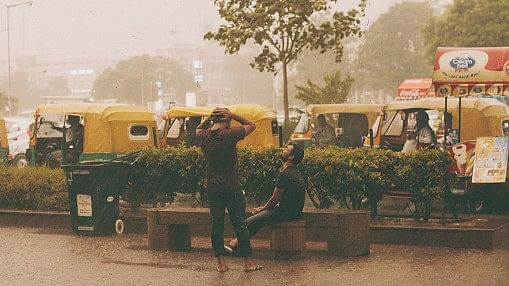
Rains in Delhi.
Credit: iStock Photo
Following a meeting with a team from IIT-Kanpur on Wednesday, Delhi Environment Minister Gopal Rai announced that the Arvind Kejriwal administration intends to use cloud-seeding technology to generate artificial rain in an effort to reduce air pollution in Delhi.
According to the IIT-Kanpur team, six out of seven attempts at successful artificial rain trials have been conducted in Kanpur.
They also confirmed the technology's initial viability as a means of reducing air pollution in Delhi throughout the winter.
Artificial Rains
A weather modification method known as artificial rain, or cloud seeding, involves the introduction of materials into clouds to stimulate precipitation. When rain is anticipated, common materials like potassium or silver iodide, or even liquid propane (which condenses into a gas), are dispersed into the clouds to create a nucleus around which water vapor can condense, forming droplets or ice crystals.
These particles eventually merge and grow, falling to the earth as either snow or rain. One method is to disperse silver iodide into the clouds to promote the formation of ice crystals, a process referred to as "silver iodide seeding."
Both potassium iodide and potassium chloride seeding promote ice crystal formation in clouds. Silver iodide, due to its similarity to ice crystals, is particularly effective. In warmer climates, calcium chloride is a common choice, and researchers have also experimented with regular salt, or sodium chloride, for cloud seeding.
Alternative methods involve hygroscopic flares, composed of substances that induce cloud moisture. Using solid carbon dioxide, sometimes referred to as dry ice, lowers air temperature and encourages ice crystal formation.
Furthermore, electrically charged particles can influence the distribution of charged particles in clouds, which, in turn, can promote precipitation. Cloud seeding technology is highly desirable in New Delhi because it has the potential to improve air quality by removing pollutants and particulate matter from the atmosphere through precipitation.
According to experts at IIT-Kanpur, artificial cloud seeding depends on four key factors: clouds with a minimum moisture content of 40 percent, the availability of aircraft and appropriate equipment, the choice of seeding materials, and obtaining the necessary permissions, which makes its feasibility in Delhi uncertain.
According to a Times of India article dated December 28, 2021, weather conditions in New Delhi during the winter, characterized by low moisture levels, were deemed "unsupportive of cloud seeding," as reported in a Central Pollution Control Board document obtained through the Right to Information (RTI) Act. Consequently, the project was put on hold.
However, IIT-Kanpur experts have suggested that, based on current weather forecasts, there should be adequate cloud cover over Delhi around November 20–21. Officials have expressed their willingness to commence the cloud seeding operation on those days.